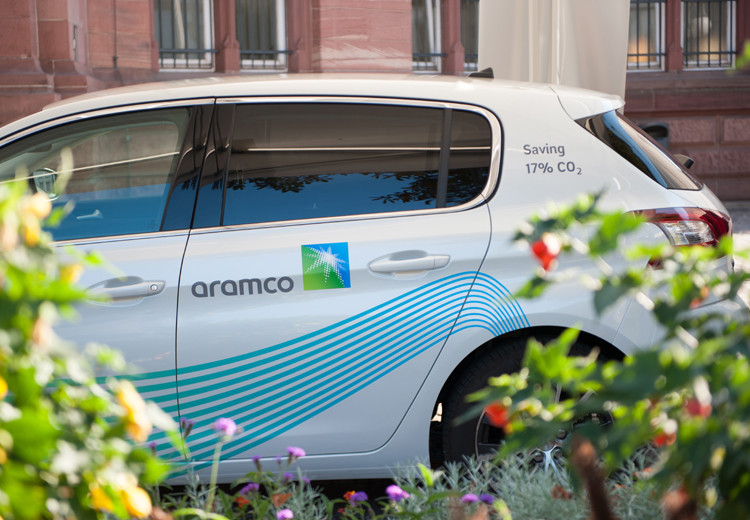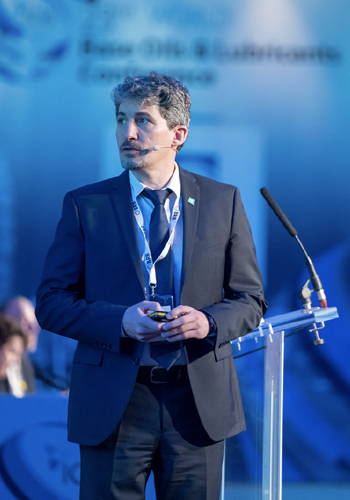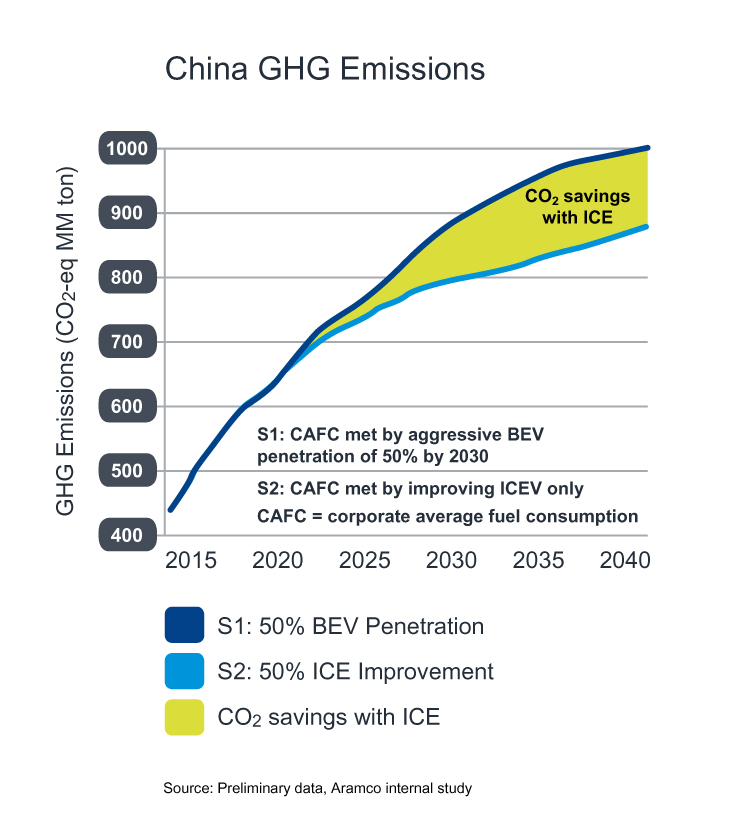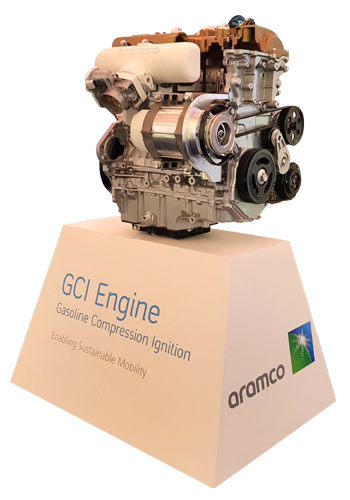Passenger cars
Severe hybrid engine oil testing
20 May 2025
02 July 2019
Fuels and internal combustion engine innovations provide route to emissions reduction

Following his presentation at this year’s London ICIS World Base Oils & Lubricants Conference, Pierre Olivier Calendini, Director of Aramco Overseas Company’s Fuels Research Centre in Paris, talks to Insight about the impact research into lower carbon fuels and advanced engine technology may have on future mobility trends.
 Pierre Olivier Calendini at the 23rd ICIS World Base Oils
Pierre Olivier Calendini at the 23rd ICIS World Base Oils Saudi Aramco, the state-owned oil company that produces 10.2 million barrels per day of crude oil is also home to a growing number of scientists and engineers who are researching new pioneering technologies.
“In one area,” Pierre Olivier explains, “we are investing in the development of technology to make petroleum energy more sustainable and accessible; working to lighten the carbon footprint of oil. In another, we are trying to advance sustainable transport through the development of, for example, ultra-clean and integrated fuel engine systems and mobile carbon capture technology.”
According to figures Pierre Olivier presented at ICIS London, global energy consumption is set to grow significantly. “Most projections see world demand rising by more than 100 quadrillion BTU by 2040, with most of this growth coming from Asia and Non-OECD countries. But,” he continues, “the increased use of renewable energy sources will not be sufficient to meet this anticipated growth, and I expect coal, petroleum and natural gas will still be used for some 75% of energy production in this time frame.”
Our intent is to contribute to reduce greenhouse gas emissions while helping to provide the energy the world needs.
The transport sector is one area that will certainly demand more energy. “The light-duty vehicle market, for example, will continue to grow, particularly in Asia and Non-OECD countries. Current data suggest that the penetration of plug-in hybrid and full electric vehicles will remain small, which means petroleum-based products will continue to be the primary energy source for the transportation sector for the foreseeable future.”
However, since figures suggest that transportation could contribute 17% to a reduction in global CO2 emissions, in order to meet the two degree scenario by 2040, the reduction of greenhouse gas emissions (GHG) from this sector is an important focus. “Saudi Aramco is exploring all opportunities to reduce GHG emissions through a life-cycle approach,” Pierre Olivier explains. “Life cycle thinking encourages the use of sound science and enables the optimum solutions to be identified through a more holistic approach. The tool is helping us to think bigger and to look beyond the obvious approaches. But,” he confirms, “it is challenging to manage as a large amount of data from different sectors is needed and collaboration between research institutes and industry is essential to get all the data in a consistent format.”
What is becoming clear in the research being undertaken is that there is no single solution that can solve the GHG issue for transport. “Obviously, e-mobility is a very good solution if the energy used is already decarbonised,” he explains. “So, this approach is particularly useful in those countries already using renewable or nuclear power. For other countries, with higher carbon intensity energy sources, I think that improving the efficiency of the internal combustion engine is still the most efficient and affordable solution.”
Pierre Olivier presented China as an interesting example, looking at two scenarios, one where battery electric vehicle (BEV) penetration reaches 50% and the other where the efficiency of the internal combustion engine (ICE) increases by 50%.
“We have taken into consideration the growth that has been forecast in demand for vehicles, and the anticipated change in energy sources, as China shifts away from coal use. The results we see indicate that improving ICE efficiency has a greater potential to reduce CO2 emissions than increased market share of BEV. And this is mainly down to the carbon intensity of the Chinese national grid.”
 In China, there is potential for higher CO2 savings from improving ICE efficiency by 50% than from 50% BEV penetration
In China, there is potential for higher CO2 savings from improving ICE efficiency by 50% than from 50% BEV penetration
“The results we have seen indicate that improving ICE efficiency is the most cost-effective and timely way to reduce GHG emissions from the transport sector - and I believe those improvements can yield dramatic results. However, a 50% ICE efficiency improvement is a huge challenge, which would require not only engine improvements but also refinery advancements.”
Saudi Aramco has identified four key areas to focus on for GHG reduction:
“On the refining side, careful gas and reservoir management means Saudi Arabia currently has the lowest carbon intensity. And, while today’s refineries are fed mainly by fossil fuels, we foresee a time when low carbon feed stocks, such as hydrogen and bio-feed stocks, will be used. These will be co-processed, allowing us to deliver lower carbon fuels to the transportation market in the future.”

Pierre Olivier says that the efficiency of today’s internal combustion engines in passenger cars is about 36%, while larger heavy-duty engines are around 47% efficient. He discussed three of the efficiency improvement technologies Saudi Aramco has been working on: the gasoline compression ignition (GCI) engine, opposed piston engine and mobile carbon capture.
“GCI is an exciting new concept that significantly enhances the efficiency of the engine through improved mixture formulation prior to combustion, which also makes it easier to control emissions. We have seen not only improved fuel economy (with a reduction in CO2 emissions by 25%) but also NOx by 90%. There are plans for a demonstration vehicle in 2021. In addition, we have formed collaborations with two OEMs with an expectation of being market ready in the coming years.”
GCI combines the best features of gasoline and diesel engines – lower emissions and higher efficiency.
“In our collaboration with Mazda and National Institute of Advanced Industrial Science and Technology (AIST) we will provide new GCI low carbon content fuels, and Mazda will contribute a high-efficiency advanced prototype engine based on their SKYACTIV technologies. The engine research is being conducted at AIST headquarters in Tsukuba, Japan. One real advantage of GCI is that it also offers the potential to utilise current gasoline and diesel engine architectures and fuelling infrastructure, significantly reducing investments and accelerating the pace of emissions reduction.”
Saudi Aramco is also working on the development of another new concept engine: the opposed piston engine. “In this design, two pistons per cylinder work in opposite reciprocating motion. This potentially reduces friction and heat losses, bringing greater efficiency, which in turn improves fuel economy and reduces emissions. It is a very versatile solution and can be configured to use either spark or compression ignition, and run on conventional gasoline or diesel fuels. We are partnering with Achates Power to develop a three-cylinder opposed piston GCI engine with the aim of demonstrating 37 mpg in a Ford F-150. As a comparison, the production gasoline F-150 V6 3.5L engine delivers 27 mpg. We are also partnering with technology developers, such as INNEngine, to explore different ways to enable opposed piston engine technology."
When combining these architectures with our other technologies there is the potential to create even greater efficiency and emissions reduction benefits.
Efforts are also underway to improve engine efficiency in the heavy-duty sector where, in a cost conscious market, any enhancements must also come with reduced cost of ownership. Here, Saudi Aramco is testing its more compact third generation mobile carbon capture (MCC) technology. ”We are running the system in Class 8 Volvo trucks and have targeted CO2 emissions reductions of 50%. We expect 10% to come from improved engine and fuel technology and 40% from the on board MCC. We are also exploring the beneficial ways this captured carbon, once offloaded, can be reused in a variety of industrial and commercial applications.”
These are just some of the not so futuristic technologies that can be applied in the coming decade to reduce CO2 emissions from transport.
“In my view," he concludes, “more efficient ICEs and lower carbon fuels will provide the best opportunity to reduce GHG from the transport sector in the near to mid-terms. What gives me some concern is that optimism surrounding alternative energies and powertrains, such as full BEV, may adversely impact the goals of reducing the GHG footprint of the transportation sector. We are committed to working with OEMs to make sure advanced ICE hardware and low carbon content fuels become widely available in the market to provide a cost-effective and timely way to reduce GHG emissions.”
Sign up to receive monthly updates via email